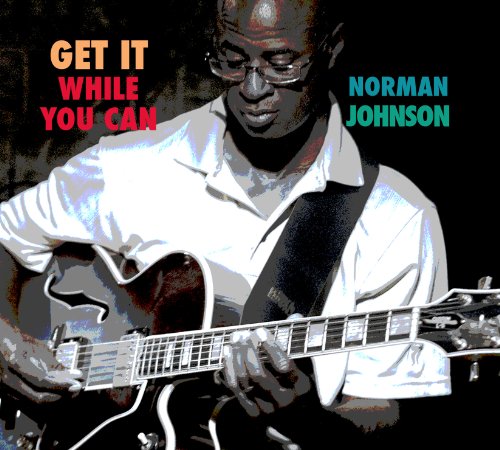
(On my path, present day.)
“Look at every path closely and deliberately, then ask ourselves this crucial question: Does this path have a heart? If it does, then the path is good. If it doesn’t then it is of no use to us.” – Carlos Castaneda
• • •

(On my path, age four, engaged in one of my favorite activities: drawing.)
“All children are artists. The problem is how to remain an artist once he grows up.” – Pablo Picasso
As far back as I can remember, which goes back as far as my before my first birthday, I loved the spell that stories, illustrations, symphonies and songs, paintings and movies put me in. Not to mention the way the air felt in different seasons, and the way sunlight looked at different times of the day. I was fascinated by trees, animals, which included dinosaurs and gorillas. And girls. There was not ever a time in my life when I wasn’t under the spell of girls. I just assumed everyone had deep feelings as I did.
While I loved being read to at night, I made up my own stories and drawing the pictures to accompany them. I would read these “books” to my parents, and they patiently listened. Soon I was reading the stories for myself. I also loved movies. They brought me to exotic worlds where all my senses were activated and inspired. To this day, when the humidity of August begins to fade, and the long shadows in the late afternoon begin to be filled with fallen leaves, I instinctively have the urge to rewatch the Beatles’ movie “A Hard Day’s Night”, because I first saw it in August while vacationing with my family on Lake Winnipesaukee. When the days begin to shorten in October and you can feel the cool Canadian air in your bones, I have the desire to reread the book I first read in fourth grade, “The Village Band Mystery” by Lee Kingman, about the adventures of some Finnish-American families in Cape Ann, Massachusetts. When March gives way to April, the rebirth of green makes me want to reread “The Wind In The Willows”, that opens with Mole doing his Spring cleaning. Christmastime finds me reliving once again the short blustery days of that Welsh village where Dylan Thomas made affectionate fun of his aunts and uncles. There are so many season and nature-inspired memories of works of art for me, the reverse is also true. In my songwriting, no matter what the subject is, I like to write about the details: the light, the feeling of the air, the shadows across faces, the roofs and porches and windows of houses, the personalities of cities, bridges, streets.
As I say in my song “Angels On My Side”:
“So many pictures my heart has taken
so many faces, so many gone
this house is full of sacred places
that will not fade my whole life long”.
To hear “Angels On My Side” click HERE.
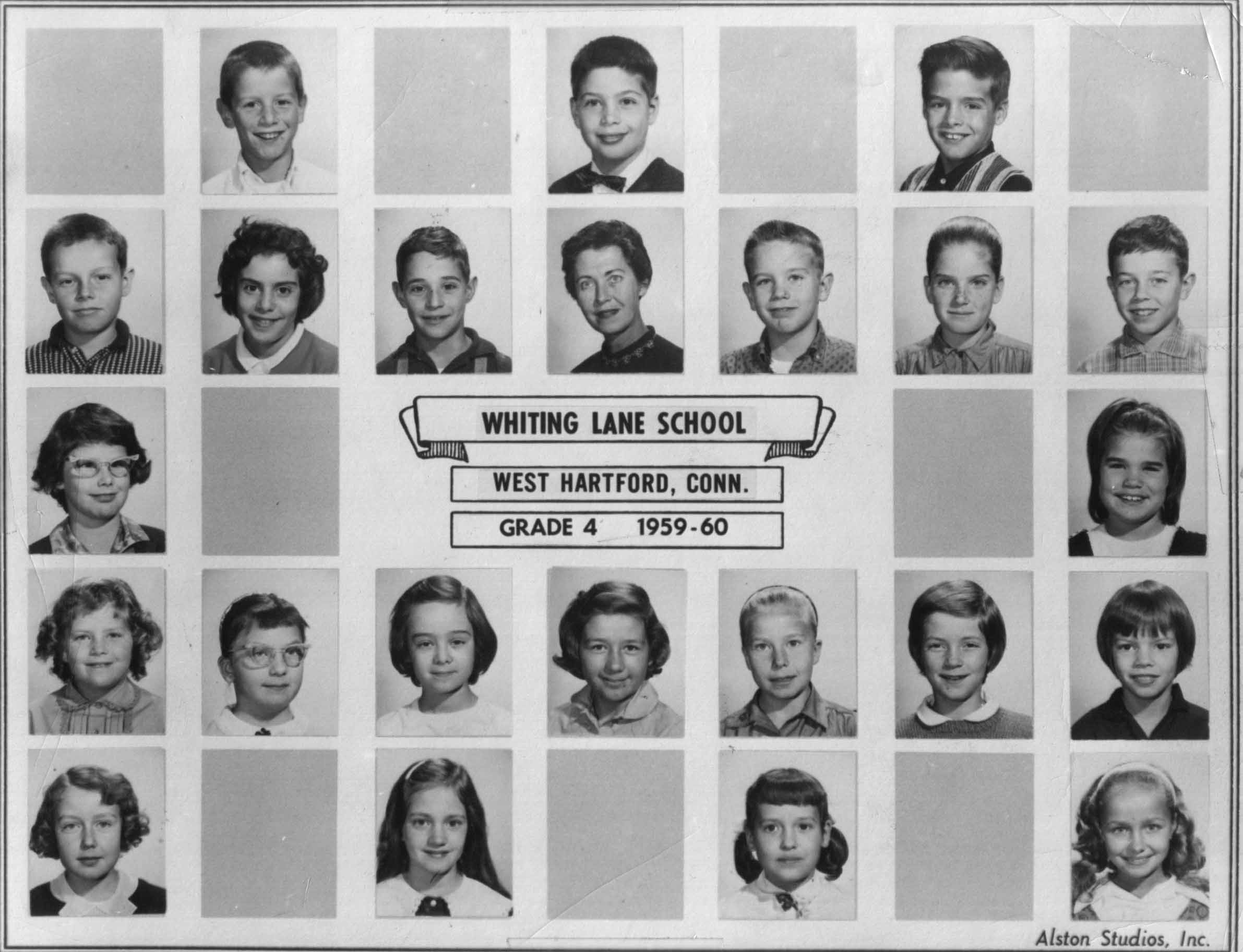
(My Fourth Grade Class Photo. I am third from the right, second row.)
During the early grades of elementary school, when our class put on plays, I was often cast by the teacher in the lead parts. I don’t remember particularly striving for or even wanting this preferential treatment but I admit that I liked being at the center of attention. I was, I definitely enjoyed making people laugh, and not just kids my own age, but grownups too. It was a kind of power I had, and it made me feel good to hear my performances inspiring laughter as well as applause. I recall an occasion when several classmates objecting to this kind of favoritism, asking the teacher why “Grayson always got to be the star.” I can’t say I blame them. I was, admittedly, as my Aunt Mary used to say, with her long Southern drawl “one double-boiled ham”.
Another thing I remember my classmates saying was “Grayson has such a WILD imagination”. That used to irritate and perplex me. I would wonder why they were saying that. Doesn’t everyone have an imagination? I considered myself to a normal kid. I liked baseball, played battle games with toy guns, rode my bike all around town with my friends. I guess my drawings, which were usually of monsters, and perhaps the fact that I liked to stand before the class and vividly describe dreams I had for “show and tell” made them say that. No other kids in my class seemed to want to do these things. I remember concluding, and I still feel this is true, that most people just don’t use their imagination much, preferring to live life very practically.
Our school had, in the second and third grades, bookshelves beneath the big windows full of books with solid orange covers. These orange books were biographies of notable Americans: Abraham Lincoln, Washington, Daniel Boone, Lewis and Clark and Sacagawea. I devoured them all. Then I wanted more.
I got a children’s library card and would walk up to the West Hartford Center and take out as many books as were allowed. I went through phases: dog books, the novels of Jack London, Edgar Allen Poe, more biographies of explorers. To this genre I added scientists, composers, artists. Having loved the Boris Karloff film, I was fascinated by Mary Shelley’s “Frankenstein: or, The Modern Prometheus”. Bram Stoker’s “Dracula” came next. I had a good friend who shared this love of Gothic monsters with me. When we weren’t playing long army games where we raided the backyard vegetable gardens of our neighbors, our idea of a good afternoon was to sit outside and read our copies of monster books. We also loved Mad Magazine and Cracked Magazine. I also liked the cartoons of Charles Addams.
One of my uncles was a film producer, writer and director. He made what were known as “B” movies, mostly action-packed dramas. He did have some well-known actors in his film. Robert Taylor did his last role in Uncle John’s “Johnny Tiger”. Taylor plays a widowed, white schoolteacher who goes to a Seminole Indian reservation. The movies also stars Geraldine Brooks, Chad Everett and Ford Rainey. uncle John also worked with Dina Merrill, Richard Egan and John Agar. When I was ten years old, I wrote a “screenplay” and gave it to my uncle, asking him to use it in one of his movies. My “screenplay” was just one long scene about a mysterious man, walking over a hill, coming into a town. Rambling on for about ten pages, I thought it had the makings of an epic film. I also asked him if he could introduce me to Hayley Mills, who I had a huge crush on, making much of my tenth year full of heartache. He said he would see what he could do about both requests.
My parents and teachers thought, for a while in my childhood, that I might become a painter or commercial artist. For as far back as I can remember, I was drawing. It gave me joy. And I remember that joy in vivid detail. I used to fill the big notebooks of cheap blank paper that my parents bought me with my drawings. My specialty was trees, dinosaurs, monsters, and, when I was in fourth and fifth grade, battle scenes. My friend Don Evans and I would lie on our stomachs in one or the others’ kitchens and draw panoramic battles on the reverse side of large drafting paper. Don’s dad was a nuclear engineer and always had sheets of it. The large paper was a great medium for our epic confrontations of armies that included different time period uniforms, weaponry and, of course, gory details of violent battle. But I always included trees, mostly blown-apart ones.
There were certain books that my parents read to me, mostly by my father, in his soothing, deep British accent that he never lost, that I loved the best: “The Wind In The Willows” by Kenneth Grahame, the Uncle Wiggily books by Howard R. Garis and “The Real Story Book” by Wallace C. Wadsworth. The illustrations for “The Real Story Book” were done by Margaret Evans Price. Her animals, details of landscapes such as bushes, reeds, trees all captivated me so powerfully that I still go back to them in my mind. Not to mention her colours, which seemed saturated with the very sky, earth and turn-of-the-century garment dyes she illustrated. I still have that book, a bit torn, with some of its illustrations embellished by my hand in pencil.
 (The illustrations of Margaret Evans Price enchanted me. Just from gazing for hours at her work, she was teaching me about shading, depth, perspective. Soon I was adorning all my drawings with those short tiny little lines, which I found out later they called crosshatching, on the edges of clothing and everything else.)
(The illustrations of Margaret Evans Price enchanted me. Just from gazing for hours at her work, she was teaching me about shading, depth, perspective. Soon I was adorning all my drawings with those short tiny little lines, which I found out later they called crosshatching, on the edges of clothing and everything else.) (Because of this illustration by Price, I am, to this day, obsessed with sumac bushes, their leaves and their conical red fruits.)
(Because of this illustration by Price, I am, to this day, obsessed with sumac bushes, their leaves and their conical red fruits.)
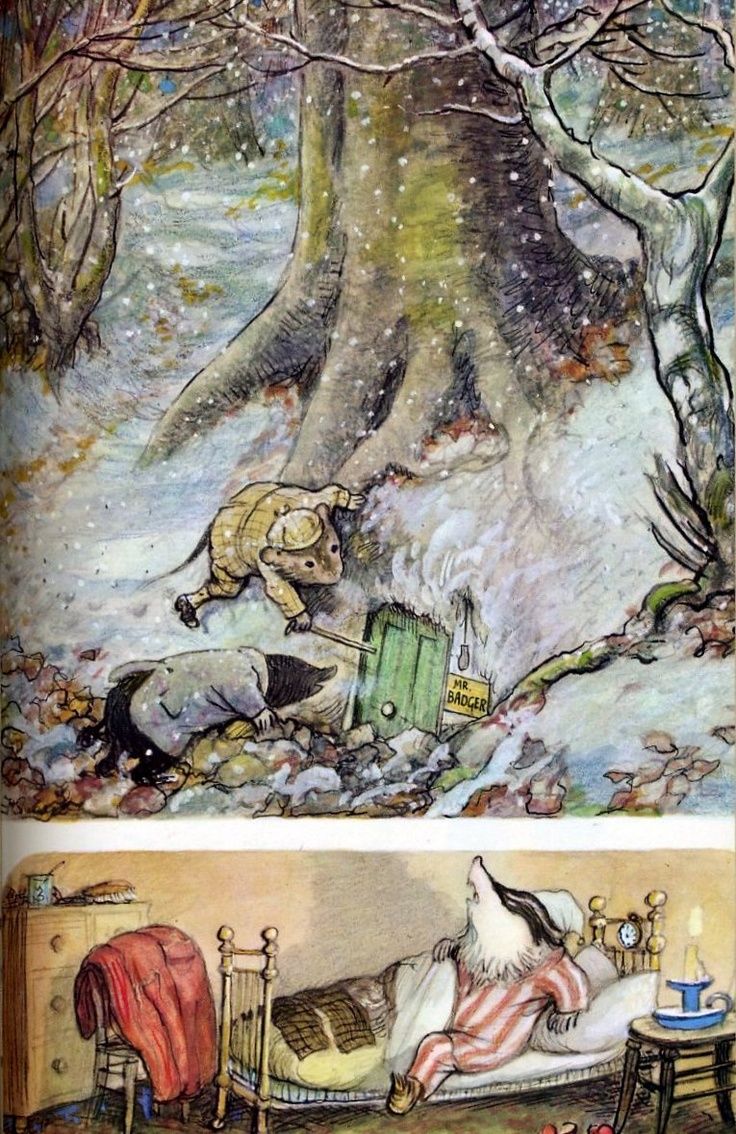 (What could be better than a cozy house beneath a big oak tree, as depicted in these illustrations by E.H. Shepherd for “The Wind In The Willows” by Kenneth Grahame?)
(What could be better than a cozy house beneath a big oak tree, as depicted in these illustrations by E.H. Shepherd for “The Wind In The Willows” by Kenneth Grahame?)
I was an avid fan of monsters, in books as well movies. On many Saturdays my mother would tell me and my middle brother Dave to take our baby brother Robbie to the double feature matinee. We would dutifully obey, taking turns holding Robbie’s hand on our walk to West Hartford Center. There we would watch double features of every imaginable variety of “B” (often “C” and “Z”) movies about space aliens, Frankenstein, The Wolfman, Dracula, The Invisible Man, War Of The Worlds, I loved them all. Robbie still remembers being scared stiff at the scene when the long arm of the alien tries to locate Gene Barry in that iconic farmhouse scene.
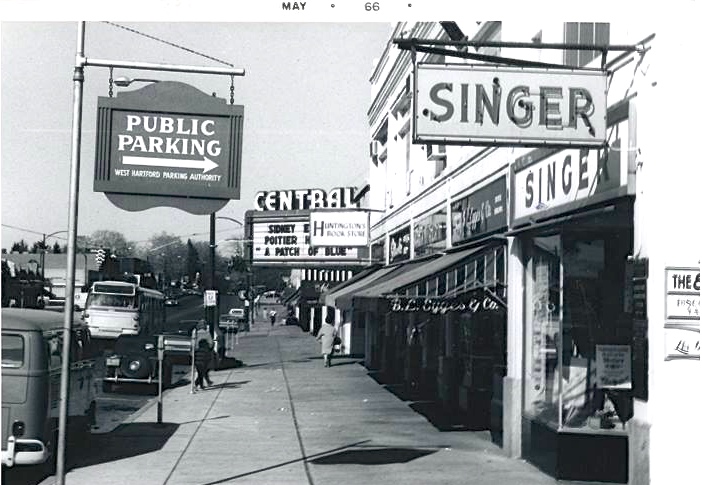
(Central Theater, 1966, in “The Center”, West Hartford, CT. The site of many a sci-fi and monster movie double feature on Saturday afternoons in the 1960’s. Photo courtesy of Tom Mahon.)
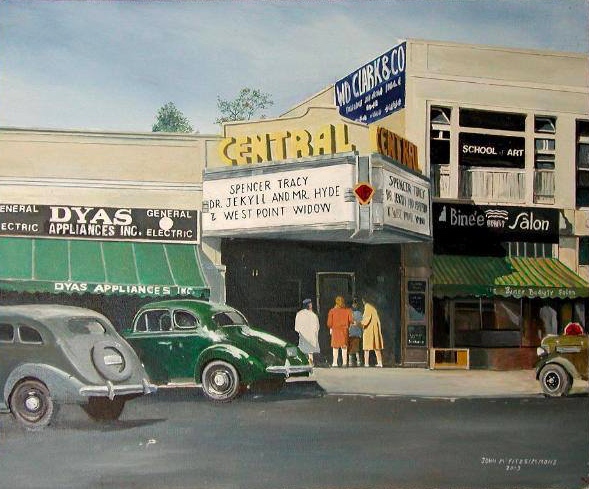
(“Central Theater, West Hartford, CT”. Painting by Dr. John M. Fitzsimmons.)

(Often, after church, I would buy the latest copy of “Monsters Of Filmland” at a newsstand that happened to be right across the street, much to my missionary grandmother’s horror.)
Eventually I outgrew the gore and monsters, to my parents’ relief, and became more and more interested in piano playing. Piano (and drums and singing) had always come so naturally to me, that I didn’t consider it “a path”. I still devoted most of my time to riding my trusty Columbia bicycle all over the neighborhood. We rode in groups, seven and eight year old bicycle gangs, as it were, all over our peaceful little suburban neighborhood. A year or two later, when some of my wealthier friends were sporting fancy “English” ten speed bikes, I developed an even fiercer loyalty to my battered old red and white Columbia. I became something of a three speed dynamo on it, and festooned it with cartoon character decals I would buy each week, with the small allowance from my parents. My favorite was a wolf.
I remember vividly the obsession I had with these decals for my bicycle. My friend Leonard Egdish and I would compare decals and salivate at the cool one the other had just bought. We would ride our bikes together up to Central Wheel on the hill leading up to West Hartford Center. I can still smell the bicycle grease and the sun-warmed wooden floors in the back of the store where the back door was often open in the Summer and where the decals were on display on a bulletin board on the wall. I’m sure we drove the proprietor crazy, as we lingered there for a good hour or two, agonizing over which two colorful decals to spend our thirty cents on. Yes, that’s what they cost. 15 cents each. That was alot of money in 1960 when I was nine, going on ten. Enough to make each decal decision very important indeed.
The rest of our days (school was but a minor and irritating interruption in our lives), we played day-long wiffle ball games that invariably got us scolded by various grouchy neighbors with equally grouchy and vociferous dogs. Then there were the Wild West and Army battles, inspired by television series like “Bonzanza”, “The Rifleman”, “Have Gun Will Travel” and World War II movies that held a sort of mystique for us, since most of our dads were veterans of that war. These battles all involved sneaking quietly around garages and behind trees, and mostly much over-dramatic falling down after being “shot” by your friends. I specialized in getting shot and falling down, and knew the best yard hills to display my gifts. I can still walk, with the accuracy of a cartographer, the lawns, garages, back and sideyards, past the lilac and other bushes, trees and gardens that were the staging grounds of our battles.
Toy guns were so much fun in the late 1950’s and early 60’s! I loved Colt 45’s, with their sleek long barrels, Winchester lever-action rifles and the tiny but dangerous Derringers, all three of which Palladin and Bat Masterson were experts with. Of course I wasn’t thinking of guns as serious weapons. I was still just a child, having fun in the fantasy world of Western television shows and movies. The only experience I had with real guns was with 22. rifle at YMCA Summer Camp. It was in the fifth grade, after my vision had dramatically improved when I discovered I needed glasses in the fourth grade. I discovered I was quite a good shot, and even won a prize or two for marksmanship.
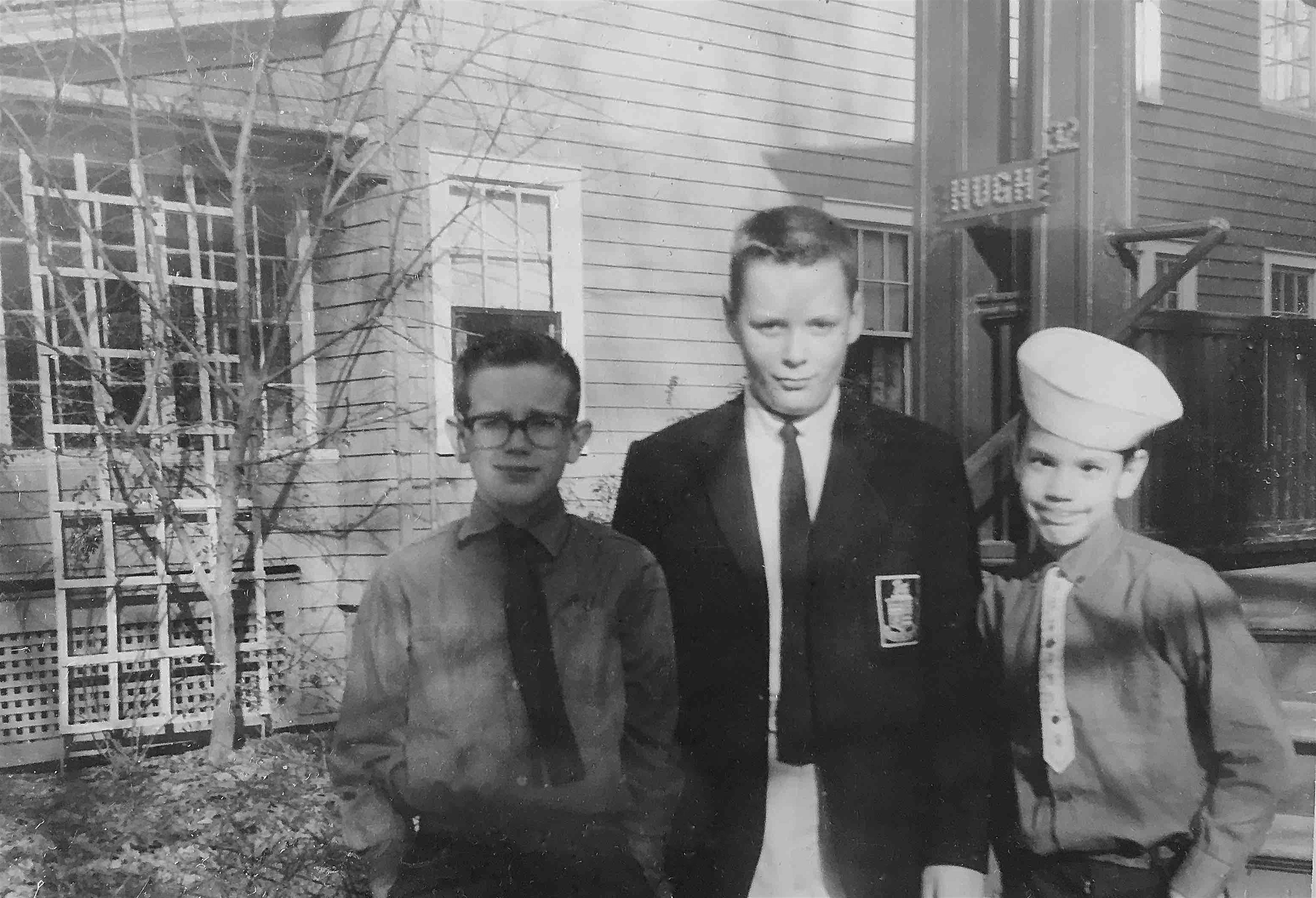 (1962, The Cool Ones. On the left is me, with my new glasses, cousin Frank in the middle, on leave from his prep school, Rumsey Hall, wearing his blazer, and brother David, wearing Dad’s Merchant Marine cap. We are standing at our house at 32 Walkley Road in West Hartford, Connecticut.)
(1962, The Cool Ones. On the left is me, with my new glasses, cousin Frank in the middle, on leave from his prep school, Rumsey Hall, wearing his blazer, and brother David, wearing Dad’s Merchant Marine cap. We are standing at our house at 32 Walkley Road in West Hartford, Connecticut.)
When my parents sent me to piano lessons, I was less than thrilled. I had already been playing any piano I could get my hands on. Our family didn’t have one until I was in the fourth grade. At my lessons, I would add my own improvisational touches to the boring exercises, much to my first teacher’s irritation. I was more happy to learn things on my own, listening to records. A neighbor from our street showed me the basics of boogie-woogie and I added that to my technique. But a classical pianist, though I loved the music, I was not meant to be. Rock and roll and jazz were calling.
In fourth grade, after seeing a jazz band at a school assembly, I begged my dad for a saxophone. Always one to encourage his son’s interests, he came through the back door after work one night with a brand new Conn Alto Saxophone. I still remember the smell of the case, the felt pads, and the whole “reed thing”, which seemed very exotic to me. Rico, Number 2 and a half, Alto. Soft enough to bend notes, but not on the ridiculous side of soft as to be a wambly, honking mess. The softening of the reed in your mouth for ten minutes or so always reminded me of sucking on a piece of bamboo.
I took lessons from Lou Solloway, a former member of Woody Herman’s big band, for three years, from fourth through my sixth grade, in the back of Pearlmutter’s Music Store in Hartford, Connecticut. In the sixth grade, he invited me to play in his big jazz band, which rehearsed at the Jewish Community Center in West Hartford, and gave a few concerts a year. That was a thrill, playing with the big guys. From seventh grade through age eighteen , I studied with Hartford Symphony First Clarinetist/Alto Saxophonist Henry Larsen. I would practice in our third floor hallway, which had great natural reverb, the sound carrying down the staircase over the balcony.
My material? Boots Randolph, Paul Desmond, later it was Charlie Parker, Ornette Coleman, Junior Walker. When I was ten, I would put The Dave Brubeck Quartet’s “Blue Rondo A La Turk” on my dad’s stereo and pace through the dining room and living room, playing along with Paul Desmond’s solo until I had it down note for note. I did the same with Boots Randolph. I played alto mostly, but I also played baritone in seventh grade dance band, First Tenor in eighth grade, and First Alto in ninth grade and in high school.
To hear one of the only existing recordings of my alto sax playing, from my self-titled 1980 album playing click HERE.
I still drew, but mostly that part of my brain emerged only for family Christmas cards and drawings for friends.
 (A Christmas card by me, 1975, depicting Santa using dragons as reindeer substitutes.)
(A Christmas card by me, 1975, depicting Santa using dragons as reindeer substitutes.)
I was always playing music, writing stories and poems. I was captivated my dad’s African drumming records by Babatunde Olatunji (his was a very eclectic record collection) and the rhythm of soul music and blues caught my ear. In 1960 I bought Ray Charles’ album “What’d I Say” and learned his electric piano part. I could combine my love of words and visual imagery, with music. I’ll never forget the first song I wrote, in 1963, at age thirteen. My other influences were folk musicians like Dave Van Ronk, Peter, Paul and Mary and Bob Dylan, so I imitated the “Travis” finger-picking style on the piano that I still employ.
I thought much of the pop music on the radio was insipid and wimpy, preferring the exciting rockabilly of Elvis, The Everly Brothers, Gene Vincent, the bluesy songs of Fats Domino and the country piano curls of Floyd Kramer. Jerry Lee Lewis was an extension of boogie-woogie, but I didn’t care for his singing. Little Richard, now, that was some SANGIN’! And I thought it was very cool that he stood up while he played. I would use that stance on all my later tours with my bands.
But when I saw The Beatles on The Ed Sullivan Show on February 9, 1964, my thirteen-year-old brain exploded with inspiration. That was it. I knew, officially, without any doubt at all, what my path would be. This certitude about my vocation went much deeper than some lame “direction I’d like to pursue”, or “something I think I’d be good at”, mumbled without one milliliter of passion in some clueless guidance counselor’s office.
I remember, on an early August day in 1965, listening to The Beatles’ “Things We Said Today” as it played on the radio of our Rambler station wagon. My father was driving our family northward to the far, clean, wide-open lake country of Vermont, and a fully-produced documentary of my life as a successful rock musician unfolded in my brain. As I listened to the song and gazed at the scenery behind the raindrop-covered window, I remember knowing exactly what my job was. All I had to do was to capture, with just the right chords on a piano, and with just the right true, sacred words that were born from the photographs my soul was taking, all those deep moments in my life that would just float on by if I didn’t write them down. It was my mission to transcribe these feelings, and I knew that in doing this I would be creating records of human experience that not just myself, but all other people of the world could feel and understand. I didn’t formulate this mission of mine in actual words. I knew it instinctively. I knew that like a painter capturing feelings with paint, canvas, lines and colors, I would do it with music and words. It was that simple. Love, desire, passion, anger, fear, tears, the long lush brown hair of my girlfriend, her long legs in black tights, her arms, her smile, her name and face and terrifying spiritual grace that haunted me throughout the day and night, even at fourteen years of age.
And I knew in that life-changing moment that if I didn’t fully engage in this mission with every atom of my being, it would be an insult to that all-powerful, all-loving God I was brought up with. I would do it, I told myself. Sure, it might take the whole of my lifetime to do it well, but I promised myself that I would embark on this path and stay on it.
God was listening.
• • •
In those nascent days of my songwriting, I already felt the powerful thrill of this craft. Whenever I succeeded in captured these wild feelings, and written them both in my mind and on paper, I would be so overwhelmed with surprise and gratitude that I would often cry, the goosebumps prickling my skin.
A fine sight I am, I would think, suddenly becoming conscious of myself, looking around, feeling ridiculous. Yet I knew, once again, I had been gifted with something.
I would be a writer, and a singer, of songs. I would be a creator of worlds.
“My music had roots which I’d dug up from my own childhood, music roots buried in the darkest soil.” – Ray Charles
The rest of my junior high and high school years were mostly spent playing in bands I formed, and waiting to get the hell out of school so I could work at music full time. And get out of school I did, early, in my junior year, agreeing to get my G.E.D. and obtain gainful employment as a dishwasher so I could afford an apartment. In junior high I formed The Braekirk Aggregation (a rock and soul cover band with an obscure Scottish name). We played The Beatles, The Rolling Stones, The Animals, The Zombies, The Blues Project, The Yardbirds, and, of course, “Louie, Louie.” When I was auditioning guitar players, the real test was how well they played a solo from that song. Next, in my sophomore year of high school, I joined The Last Five, a local band of older guys that already had a record out, the 45 single called “Kicking You”. At age sixteen, I took the place of the lead singer and pounding the Vox Continental organ. The keyboard I played, and the P.A. was provided by the flute player/backup singer that worked at a local music store. We played bars (they’d have to sneak me in sometimes since I was the only under-age one), fraternity parties and nightclubs. I played with them for just a couple years, and most of my memories of those performances and rehearsals are heavily infused with the nauseating smell of Canadian Club blended whisky and spilled beer.
 (Firmly on the artist path, 1970, with my first real band Portrait Blues. From left to right, seated: Me – lead vocals, keyboards and songwriter; John Weber – guitar, David Stoltz – bass guitar. Left to right, standing: Mark Kaplan – tenor sax and flute, Ralph Rosen – drums and blues harp.)
(Firmly on the artist path, 1970, with my first real band Portrait Blues. From left to right, seated: Me – lead vocals, keyboards and songwriter; John Weber – guitar, David Stoltz – bass guitar. Left to right, standing: Mark Kaplan – tenor sax and flute, Ralph Rosen – drums and blues harp.)
The first band I formed that played my own songs was Portrait Blues. I started it with a bass player I met at a party named David Stoltz. We later added Ralph Rosen on drums, John Weber on guitar and Mark Kaplan on tenor sax and flute. Ralph also played an incredible blues harp, so when he got his harp out and sang a blues, I would get on the drums. We played together from 1969 until 1973, when our guitarist left the civilized world and joined a monastery. This band was a huge joy for me. I would stay up all night in my apartment, composing and writing out the parts for a new song, and the next day I’d bring it to the band to rehearse. They were all extremely good at their instruments, so usually by the end of that rehearsal the song would be pretty much ready to be performed. It was a blues and soulful rock band with elements of jazz and what might be called ‘progressive rock’ today. There was also a deep, juicy sense of humour, and a love of the surreal and the spiritual in life that bound us together. We were not just band-mates, we were great friends.
To hear Portrait Blues’ recording of my song “Spring” click HERE.
(Portrait Blues recording session, 1970. Clockwise: me on piano and vocals, Ralph Rosen on drums, Dave Stoltz on bass, Mark Kaplan on tenor sax, John Weber on guitar.)
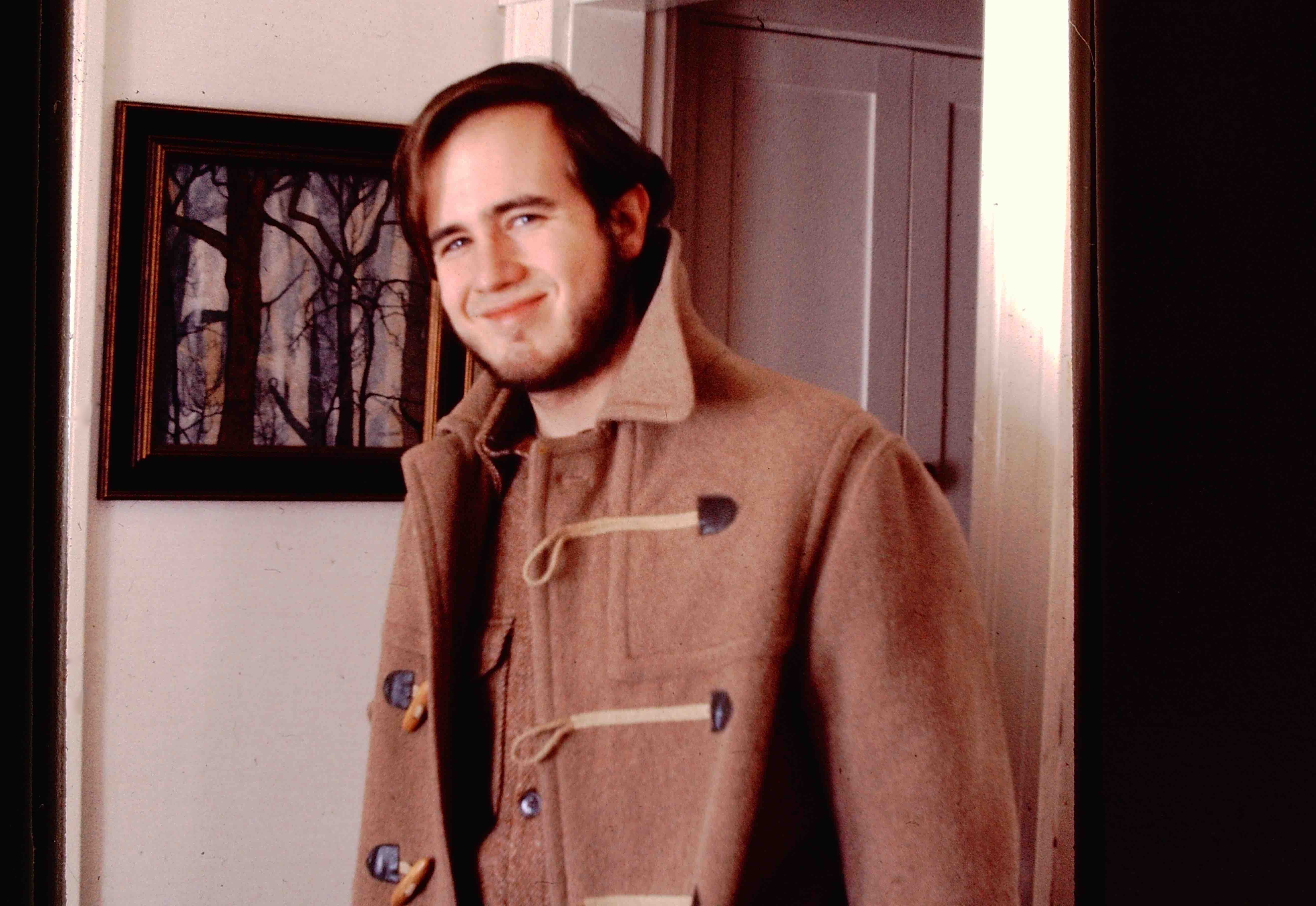 (Me in Newton Corner, Massachusetts, 1976.)
(Me in Newton Corner, Massachusetts, 1976.)
“My style of songwriting is influenced by cinema. I’m a frustrated filmmaker. a fan once said to me, ‘Girl, you make me see pictures in my head!’ and I took that as a great compliment. That’s exactly my intention.” – Joni Mitchell
In 1976, I saw a notice in the Hartford Advocate about an independent filmmaking school in Guilford, Vermont. It was called The Atelier. Founded by a Swiss-American filmmaker whose name escapes me now, the only requirement for admission consideration was an essay. The subject for the essay was the reasons why you wanted to be a filmmaker. Tuition, if you were selected, was free, The only fees, were modest living expenses in a communal house. I couldn’t believe it! Over the course of several nights, I wrote a forty page (typed, single spaced) piece detailing my aspirations as a filmmaker, including in it my favorite films, directors, a portion of a screenplay, what I did and didn’t like in movies, and a brief history of not only myself, but Art in Western Civilization, if I recall correctly. I told my girlfriend (we were living together at the time) about it, and, though it meant we would be apart, she was behind me 100 per cent. That alone gave me an instant stomach ache, a headache and anxiety. But I was determined to see this through.
I received a phone call a couple of weeks after mailing my short novel to the address in the ad. It was the head of the school and he said I was in. We scheduled an appointment to meet at the school where I’d be given a tour of the place. We could discuss the living costs and other details then, he told me.
My girlfriend dropped me off (I still didn’t have my license) at the bus station in Hartford. From there I took a Greyhound bus to Brattleboro, Vermont. The bus stop at Guilford was a small gas station in the middle of huge, empty and quite beautiful fields. As instructed, I used the gas station pay phone to call the number given to me, and in about twenty minutes, a station wagon pulled up, and the passenger door swung open, revealing a large, disheveled bear of a man wearing, of all things, a beret.
We returned to the school, which was a group of several old houses, The whole place looked like a farm, because that’s what it once was. After telling me he liked my essay, although it may have been a hair lengthy, he (I can’t recall his name, and no information exists online of this school) gave me a tour of the various buildings, including the “dorm”, communal kitchen, dining room, movie theatre and animation studio. Whoa! Animation studio? There was nothing in the notice about this being about animation filmmaking. But yes, that was, indeed, what this school was. And your “study”, as he described it, pretty much consisted of was carrying out his ideas, doing errands and chores and learning the art of animation. The students at The Atelier were, in short, poorly paid employees who helped this person make his animated films.
I would not be one of them.
Polite as always, I waited for an opportune pause in his tour presentation, and expressed my thanks but told him this was not at all what I was looking for as a student of film. He told me I was passing up a great opportunity, and I told him, again, thank you and proceeded to walk back the four miles to the small gas station, where a Greyhound bus would be passing on its way back to Hartford in approximately three hours. Chalk it up to a life experience, I told myself, as I read, re-read and read again the packets of flower seeds on a rack.
Not to be deterred, a month later, in September 1977, I enrolled in a course on independent filmmaking at The University of Bridgeport which met once a week. It was a non-matriculated course. From the ten times this class met, I got some ideas of hand-held and guerilla-style 16 millimeter camera techniques, and watched the teacher’s independent film. Shortly before the Spring semester was to begin, there was a professor’s strike and the class ended. I got some money back.
So instead of becoming a filmmaker, I made movies that happened to be songs. “Bluewhite”, written in 1977 and one of the songs on my 2010 album “An American Record”, is a perfect example. To see and hear it click HERE.
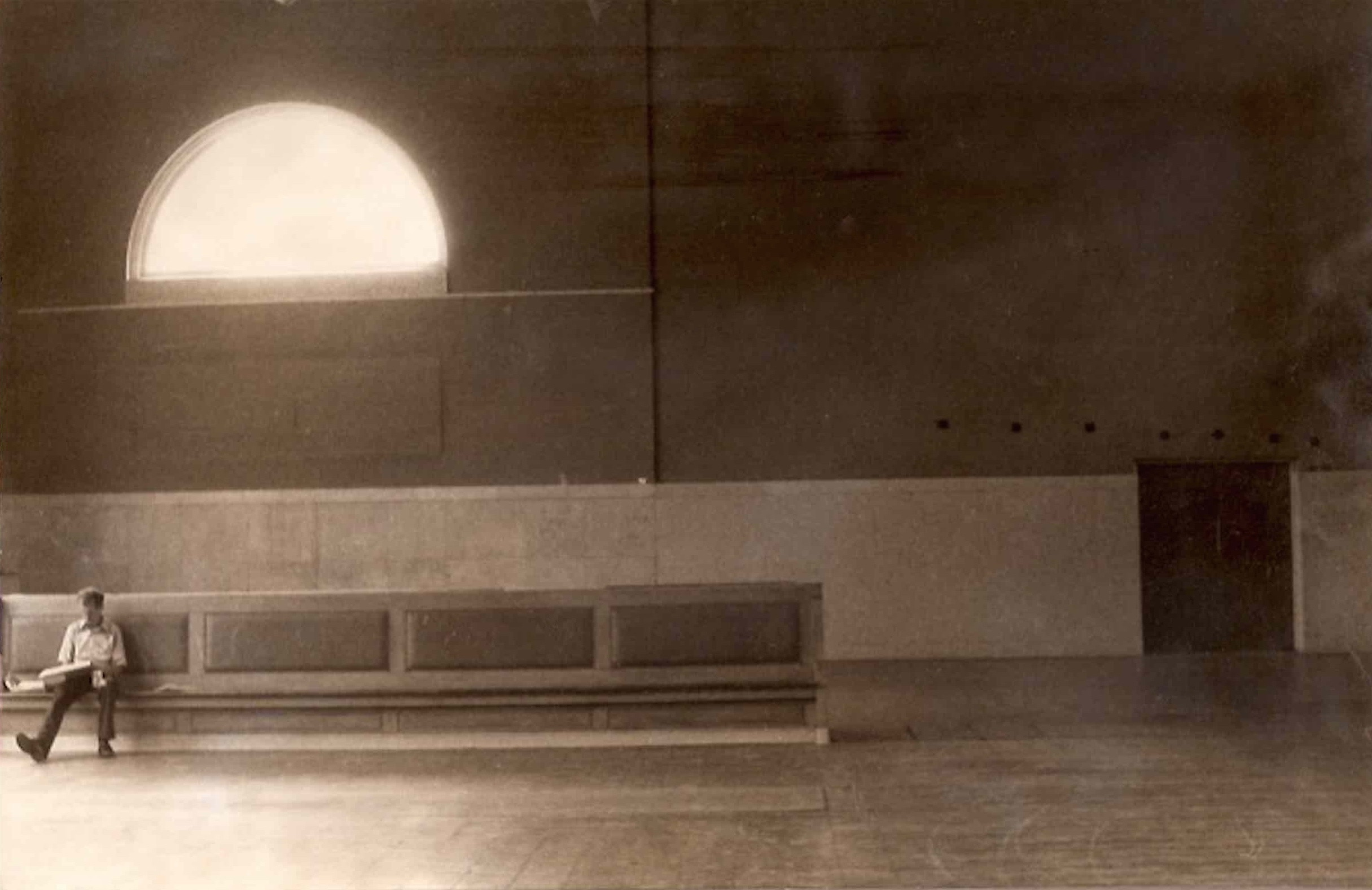
(I passed through the Hartford Train station, known as Union Station, many times. I took this photo with my Miranda 35mm single-lens reflex camera, a birthday gift from my mother.)
I decided I would give this filmmaking thing one more try, So in November 1977 I called NYU and asked for the Film Department. I was put through to the head of the Department Film Haig Manoogian (Martin Scorsese’s mentor). After speaking with him for a while, he said he would see me in his office. A few days and another Greyhound bus ride later, I was in Professor Manoogian’s office at the Greenwich Village campus of The Tisch Shcool Of The Arts at New York University. Having read some of my screenplay ideas, Manoogian saw my passion and was impressed, he said. But when he asked me how I would feel taking the prerequisite general education classes, it made me pause. I left his office that day, telling him I would get back to him within one week about the scholarship and thanked him for his time. As I walked around the streets of New York towards the bus station, I knew in my heart that my destiny lay with music. Going into filmmaking was not meant to be, I told myself. I knew I was not prepared to do what it would take to devote myself to this study. Suddenly I was no longer torn about this question. But it took the act of physically going to New York and spending an hour in the office of one of the most respected people in the field, to clear my mind. From then on, I put all my energy into writing, recording and performing music.
I returned to the medium where I felt completely at home. Music and words. Songs. Or as Pulitzer Prize-winning columnist, author and former music critic Leonard Pitts Jr. so accurately put it, in his review of my 1992 album “Road To Freedom”: “If you love words, if you’re one of those people for whom heaven is a rainy day and a good book, then know this: Hugh doesn’t write words — he writes pictures.” – Leonard Pitts Jr., Miami Herald, October 19, 1992
 (Getting out of Dodge. Hartford’s Union Station, headed south toward New York City.)
(Getting out of Dodge. Hartford’s Union Station, headed south toward New York City.)
“You can only lose what you cling to” – Buddha
Sometimes your path leads you to a new place. I put off moving out of “Dodge” (what I sarcastically called Hartford, Connecticut in the early to mid 1980’s), until I don’t think I could have physically or emotionally endured one more month, week, day – hell, one MINUTE in a place that clearly offered me no future. I could see my friends settling down, getting married, carving out nice little ruts in which to live the rest of their lives. Meanwhile I was playing in a jazz fusion band that I had quickly grown bored with and was accompanying modern dance classes at The Hartford Ballet. I was writing my own songs, saving them for a record that I was convinced I could make somehow, sometime soon. For extra confusion, in 1984, at the age of thirty four, l fall head over heels in love with an eighteen year old girl, one of the dancers studying in the teacher training program there. A year later, the age difference finally became clearly an insurmountable obstacle and I was single again. But not for long. At the club where I played in the boring jazz fusion band, I met the ex-girlfriend of a guitarist I had worked with off and on. Soon she was my girlfriend. We spent nearly every day of the Summer of 1985 together. It was very deep. We declared our love for each other. I wrote poems and songs about and for her. Then, at the end of that August, she told me she had accepted a job in San Francisco. No problem. We’ll have that most romantic of love affairs: a long distance relationship. Bullshit. A few months and a few round trip flights to San Francisco later, we broke up in grand style, standing in the grass of the great meadow outside the Ahwahnee Hotel in Yosemite National Park.
To hear “Over The Wires”, a song I wrote about this long distance love affair, click HERE.
“The only sin is mediocrity.” – Martha Graham
I had no desire to be merely comfortable or to settle for a boring life. It came down to this: I knew I was a talented as anybody making records in the mid 80’s, if not better (there was never anything wrong with my ego). Now I had to get the world to see and hear that. In one of my school notebooks that I wrote in, I made a list of the places I should go where I could get a record deal. The list was short. 1) New York, 2) Los Angeles and 3) London, England. I had a couple friends in Los Angeles and some family in London, but the expense of just getting there loomed as a large impasse in my mind. New York won out by default.
I had to get away.
Click HERE to see a video of my band Grayson Hugh & The Wild Tones performing my song “I Had To Get Away”.
I started taking day trips into New York, armed with cassettes of my songs I had recorded at a 24 track studio in Connecticut that a friend of mine, Ron Scalise, co-owned and was head engineer at. Ron would also turn out to be the ex-husband of the woman I would later marry, but that is a whole other story. I would make lists of names of anyone associated in any way with bands and artists, then track down their phone numbers or addresses. It was literally a knocking-on-doors campaign. It was a first step.
The drummer of one of my bands, ex Pairlament-Funkadelic member Tyrone Lampkin, gave me keyboardist Bernie Worell’s number. I called him and met him at a recording session he was doing with producer Arto Lindsay. He listened to some of my songs (I had brought my Sony Walkman and headphones) and his eyes lit up. He called out to the other guys “Hey guys! Check this cat out!” I asked him to keep me in mind for any recording or touring work. He said he would, but nothing came of it.
Another drummer in one of my bands that I had known since junior high school gave me the numbers of bassist Fernando Saunders, who was playing with and producing Lou Reed. The other number belonged to drummer and producer Narada Michael Walden.
I knew exactly one person living in New York. Well, that’s not entirely true. Family friends Betty Allen and Ed Lee lived on Riverside Drive. Aunt Betty (as I grew up calling her) was an internationally acclaimed mezzo-soprano opera singer and appointed Director of the Harlem School of The Arts in 1979, by the former Director Dorothy Maynor. But I hadn’t seen her and Ed in thirty years; I couldn’t just call them up and ask if I could crash on their couch.
So I called the other person I knew there. The fact that she was an ex-girlfriend didn’t deter me in the slightest. We had lived together when she was studying dance at the Hartford Ballet and I was the modern dance accompanist there. She escaped (wisely) in 1976 from my increasingly frequent bouts of drinking and hitchhiking to Maine which I’m sure scared her. Hell, it scared me. I wasn’t yet ready to do anything about it, however. Her mother gave me her phone number in New York. I called her and we agreed to get together to talk about how she might help. At that point, we were on friendly terms.
She told me she had married the owner of a chain of funeral homes and had also converted to Judaism. It turned out that she did know some people in both the music and movie business. How I was never quite sure, but, as she was quite pretty, I could imagine older men in positions of power being attracted to her. She knew people like legendary film producer Sam Spiegel and Atlantic Records head Ahmet Ertegun.
She arranged a meeting with Ahmet and he appeared very distracted, as if he couldn’t care less. He was looking through his mail while he listened to one of my songs from my 1980 self-titled album. It was called “When You’re Young And In The Picture”. It was one of those time when people listen to my music when I am present, when my jaws clench and every muscle in my face and arms and legs seem frozen. I hate it. I’d rather be far away when somebody listens to my music. After it was over, he remarked “It’s kind of simple, isn’t it?”
I had the urge to slap his face. Here’s a guy who wrote “Chains Of Love”, “Mess Around” and”Sweet Sixteen”, the epitome of ultra simplicity. It was obvious that he just wasn’t present in the moment, he wasn’t really listening. If he had, and listened to the ending of “When You’re Young & In The Picture”, he would’ve heard the non-simplicity and interesting jazzy depth of that section. A connection with Atlantic Records was not meant to be, I quickly concluded. It was obvious that he was just half-heartedly doing a favor for my ex-girlfriend. All I knew was that she and another young female friend had joined Ertegun on Summer vacations. It was all just a bit creepy to me.
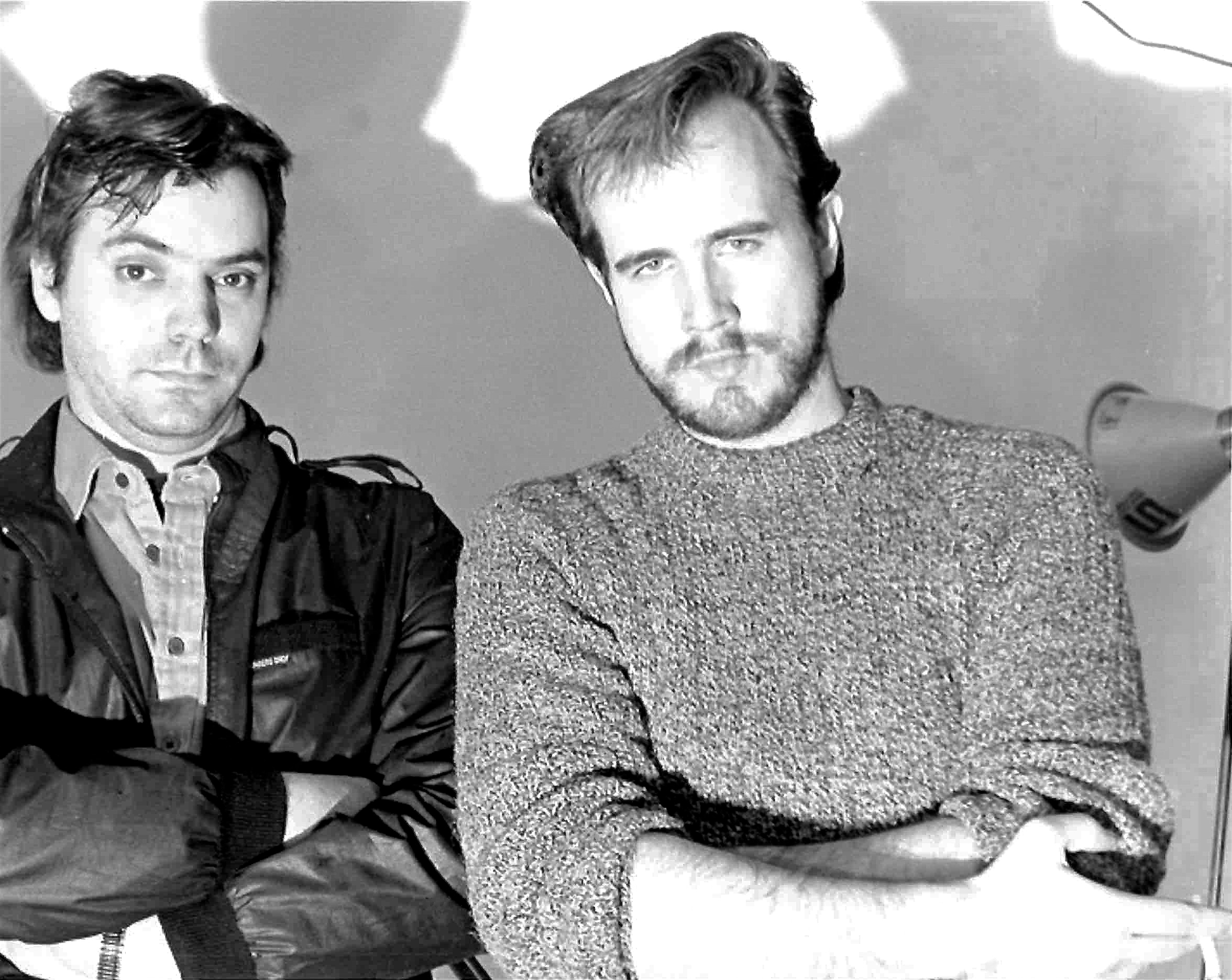
(Me, on right, and my good friend Ron Scalise, in 1980. Ron not only recorded and mixed my 1980 album “Grayson Hugh”, he took the tapes down to legendary Criteria Studios in Miami, Florida and mastered the record himself. Eric Clapton’s huge hit “Layla” was recorded there, as well as The Allman Brothers’ third album “Eat A Peach”, and The Bee Gees’ “Main Course” and “Spirits Having Flown”. We were both perfectionists and this photo caught us in that extremely prolific time of our lives, our early thirties. We were so “young and in the picture.”)
To hear “When You’re Young & In The Picture” click HERE.
In 1986, after hemming and hawing for a good ten years, I left Hartford, Connecticut for good and moved to New York City. My apprenticeship as the artist I was meant to be was over. Perhaps I waited longer than I should have, but that reluctance was what it took to get me to the point of unbearable unhappiness. I had to stop reading The Village Voice, which used to be so enjoyable for me, because my jealousy at reading about other musician’s concerts or records filled me such a rage, I would throw the paper across the room and curse loudly. At 35, I was still relatively young, but I had become a very bitter person. Even with my lack of objectivity, I had read enough novels and seen enough movies to know I was in danger of becoming “that cranky guy” with a bad case of sour grapes. The thought of me at age 70, boring people with my “I coulda been a contender” soliloquy, filled me a dread worse than my fear of failure.
So I resolved to snap out of my inertia, tuned in to my very healthy ego and forced myself to get the hell out of Dodge.
I told myself that I would live there, by whatever means it took, and not leave until I got a record deal.
That’s what I did. And amazingly, I did get that record deal, with RCA Records. Not overnight. It took a good year. But it actually happened. I still remember the moment I heard my A&R woman’s voice on the other end of the phone saying “Grayson, we here at RCA have decided to sign you”.
I know how fortunate I was, believe me. The odds of getting signed to a major record label, at any time, are not very good at all. You have a better chance at winning the lottery.
I always tell people that it wasn’t the eleven months of camping out in a friend’s barber’s basement room, sleeping on an army cot that was the most difficult thing. Not being cold in that unheated space during the Winter months. Not the feeling of hopelessness that would overwhelm me as I commuted back to Hartford on weekends to play in a wedding band, while I worked at Sarah Lawrence College during the week, accompanying for dance classes. It wasn’t the physical discomfort, or the anxiety and the ego-killing doors that were slammed in my face for a year.
It was the leaving that hometown and striking out for the unknown, following my dream, that was the hardest thing. It was that leap of faith that took the most courage. Everything else was up to God.
The path of the artist is definitely not an easy one. But if painting a picture, or making a photograph or film, or writing a poem, a book or a song is the thing that gives you that ineffable ecstatic feeling that makes your soul fit into it’s true shape, then it’s the only path.
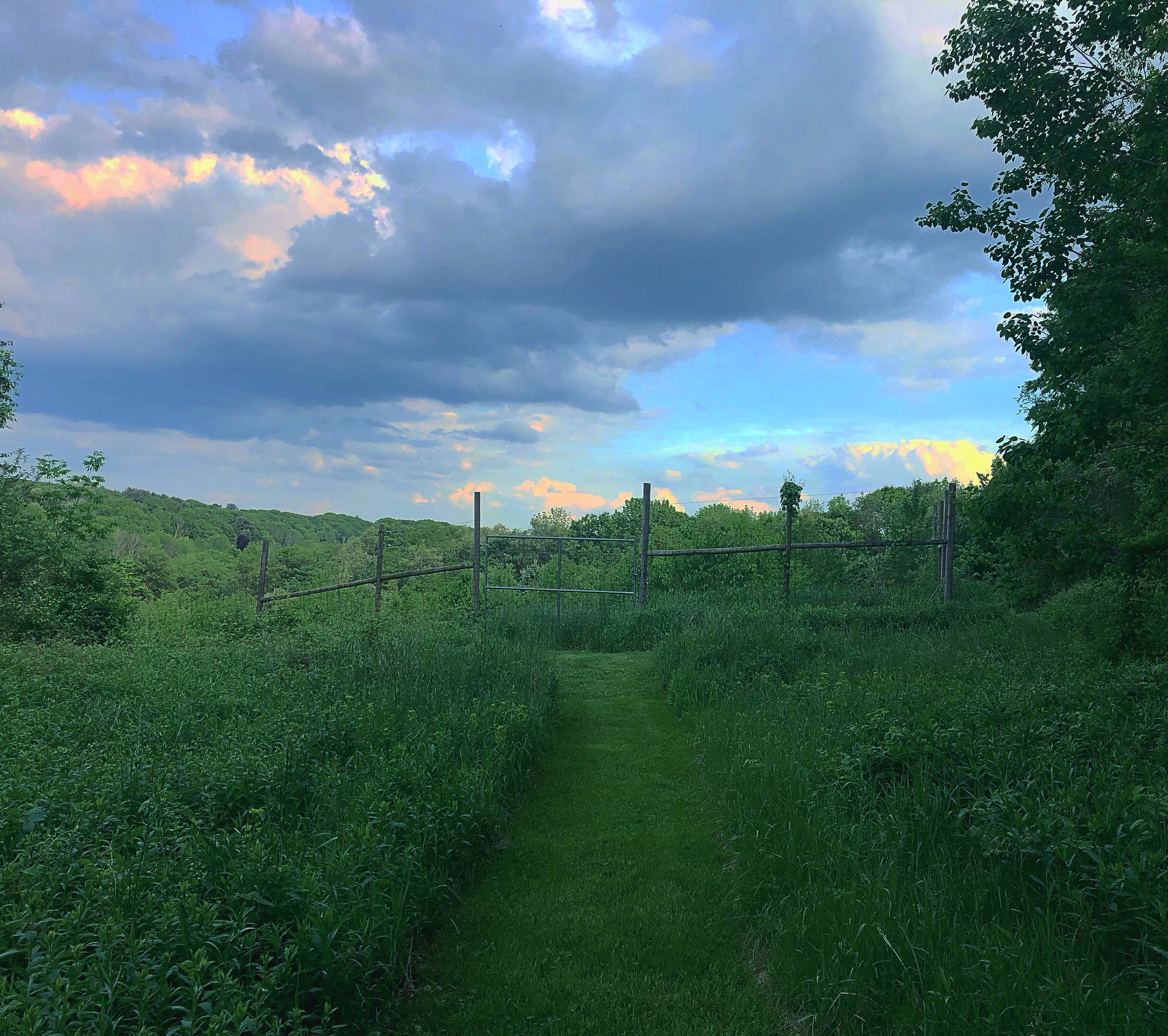
• • •

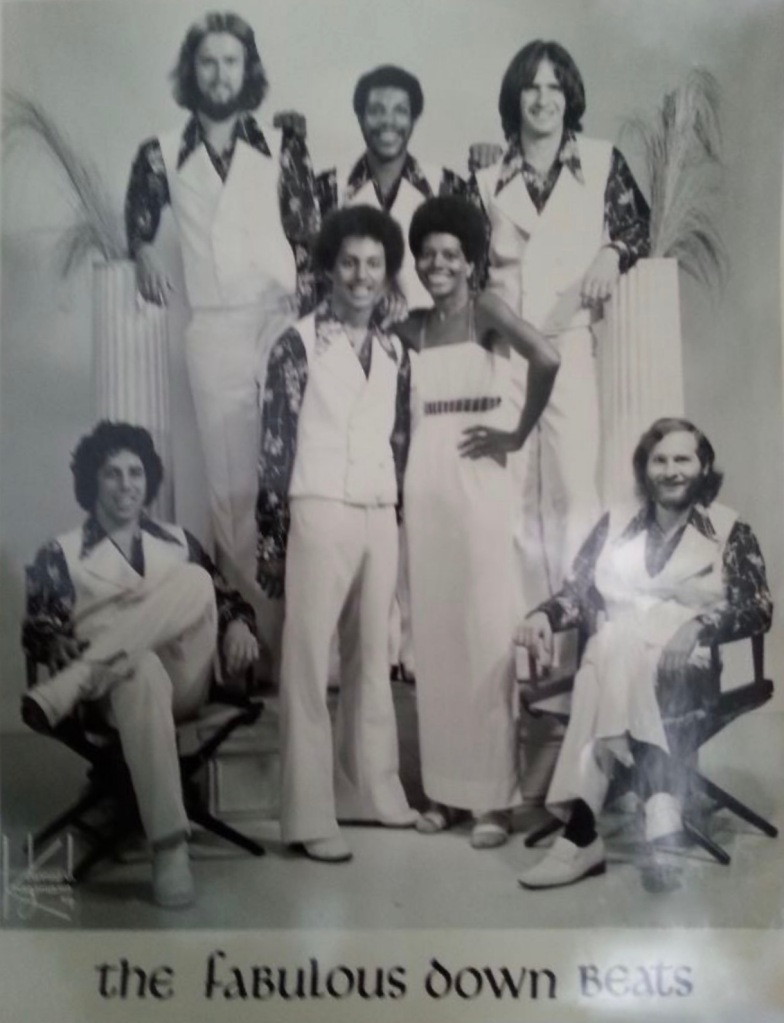









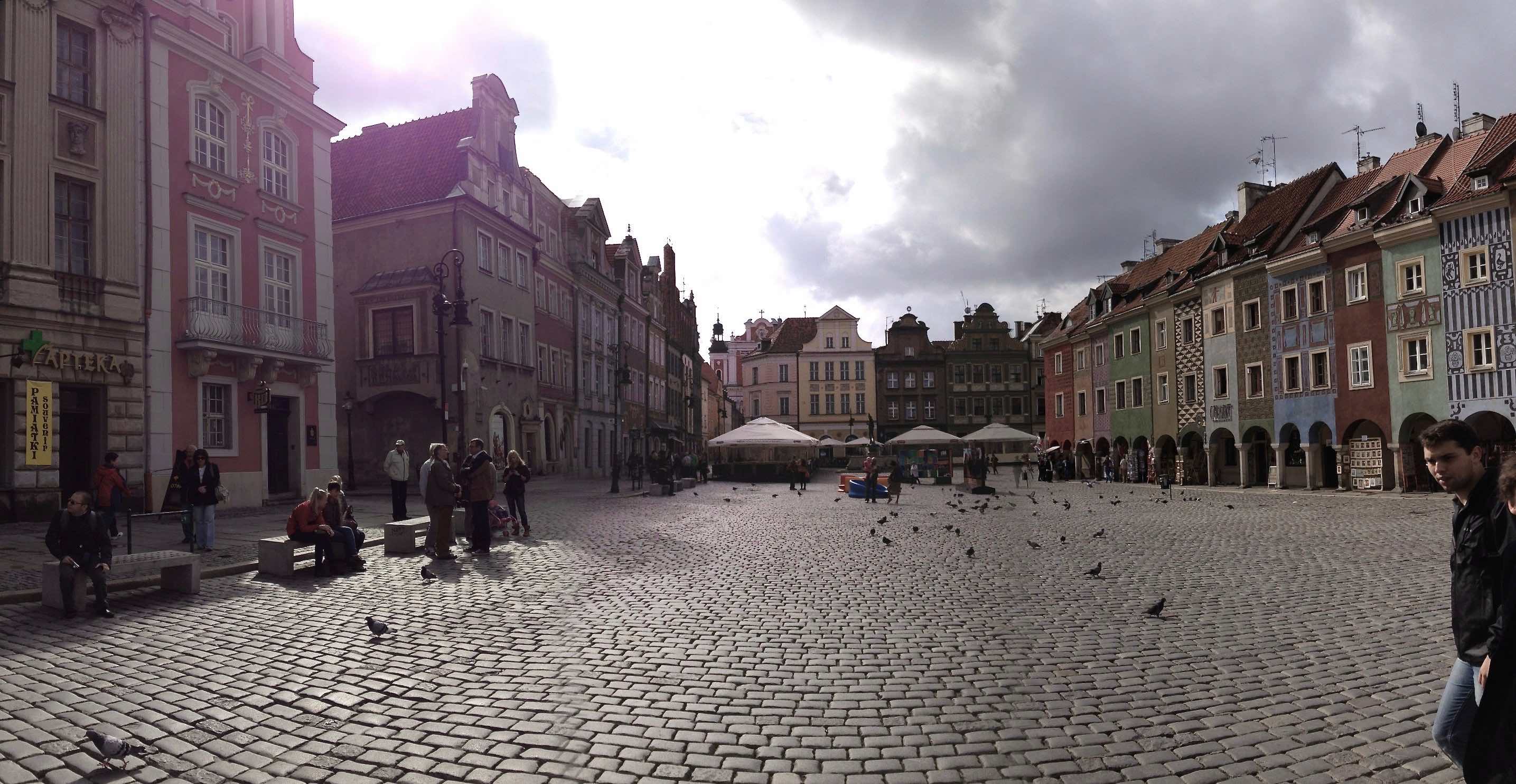



 (The illustrations of Margaret Evans Price enchanted me. Just from gazing for hours at her work, she was teaching me about shading, depth, perspective. Soon I was adorning all my drawings with those short tiny little lines, which I found out later they called crosshatching, on the edges of clothing and everything else.)
(The illustrations of Margaret Evans Price enchanted me. Just from gazing for hours at her work, she was teaching me about shading, depth, perspective. Soon I was adorning all my drawings with those short tiny little lines, which I found out later they called crosshatching, on the edges of clothing and everything else.) (Because of this illustration by Price, I am, to this day, obsessed with sumac bushes, their leaves and their conical red fruits.)
(Because of this illustration by Price, I am, to this day, obsessed with sumac bushes, their leaves and their conical red fruits.) (What could be better than a cozy house beneath a big oak tree, as depicted in these illustrations by E.H. Shepherd for “The Wind In The Willows” by Kenneth Grahame?)
(What could be better than a cozy house beneath a big oak tree, as depicted in these illustrations by E.H. Shepherd for “The Wind In The Willows” by Kenneth Grahame?)


 (1962, The Cool Ones. On the left is me, with my new glasses, cousin Frank in the middle, on leave from his prep school, Rumsey Hall, wearing his blazer, and brother David, wearing Dad’s Merchant Marine cap. We are standing at our house at 32 Walkley Road in West Hartford, Connecticut.)
(1962, The Cool Ones. On the left is me, with my new glasses, cousin Frank in the middle, on leave from his prep school, Rumsey Hall, wearing his blazer, and brother David, wearing Dad’s Merchant Marine cap. We are standing at our house at 32 Walkley Road in West Hartford, Connecticut.) (A Christmas card by me, 1975, depicting Santa using dragons as reindeer substitutes.)
(A Christmas card by me, 1975, depicting Santa using dragons as reindeer substitutes.) (Firmly on the artist path, 1970, with my first real band Portrait Blues. From left to right, seated: Me – lead vocals, keyboards and songwriter; John Weber – guitar, David Stoltz – bass guitar. Left to right, standing: Mark Kaplan – tenor sax and flute, Ralph Rosen – drums and blues harp.)
(Firmly on the artist path, 1970, with my first real band Portrait Blues. From left to right, seated: Me – lead vocals, keyboards and songwriter; John Weber – guitar, David Stoltz – bass guitar. Left to right, standing: Mark Kaplan – tenor sax and flute, Ralph Rosen – drums and blues harp.)
 (Me in Newton Corner, Massachusetts, 1976.)
(Me in Newton Corner, Massachusetts, 1976.)
 (Getting out of Dodge. Hartford’s Union Station, headed south toward New York City.)
(Getting out of Dodge. Hartford’s Union Station, headed south toward New York City.)

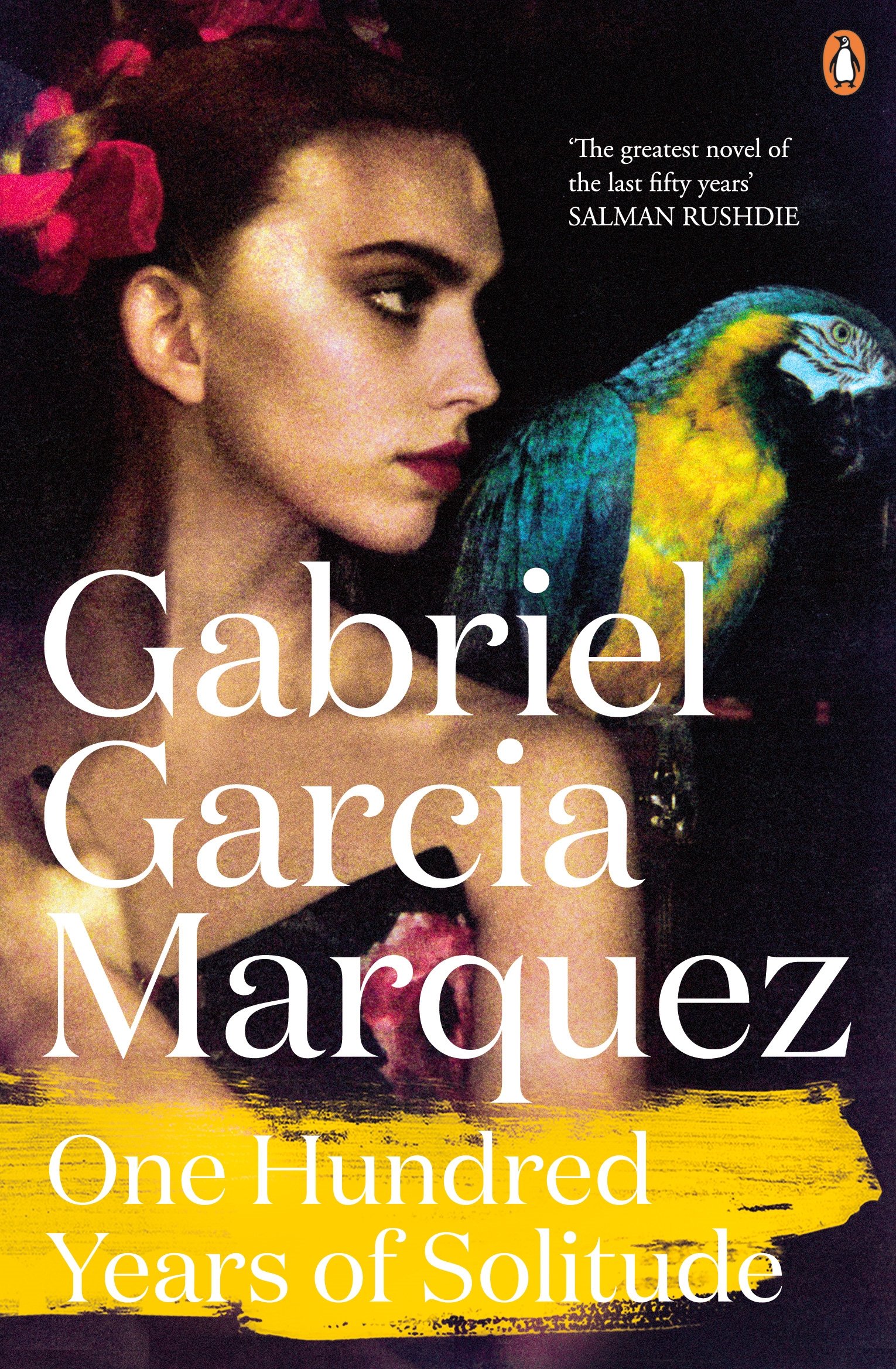
 (Photo by Amanda Sue.)
(Photo by Amanda Sue.)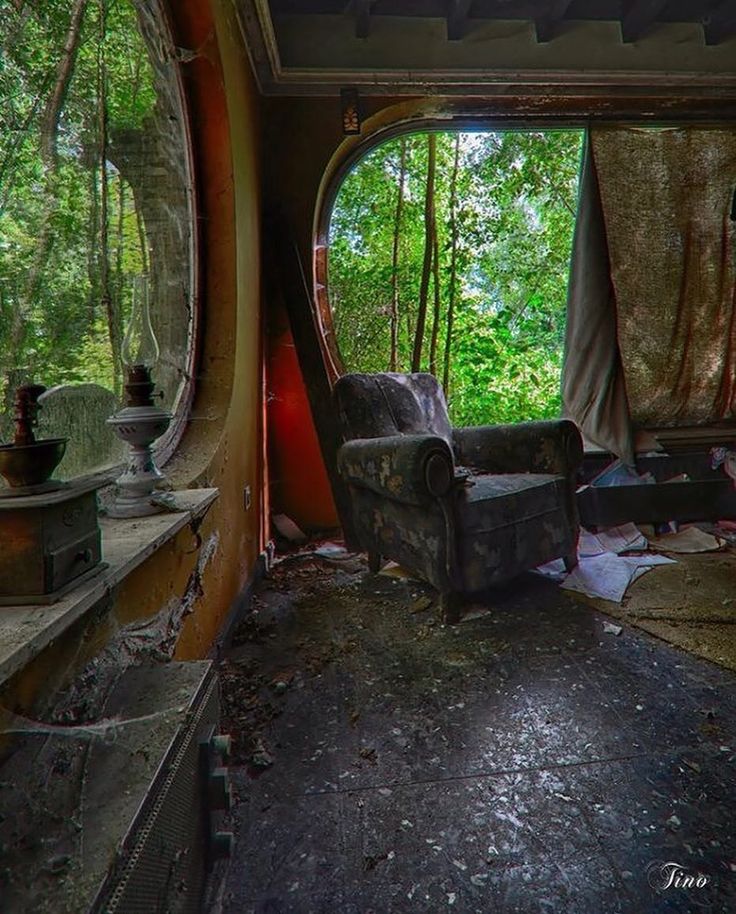 (Photo by Tino Selecta.)
(Photo by Tino Selecta.)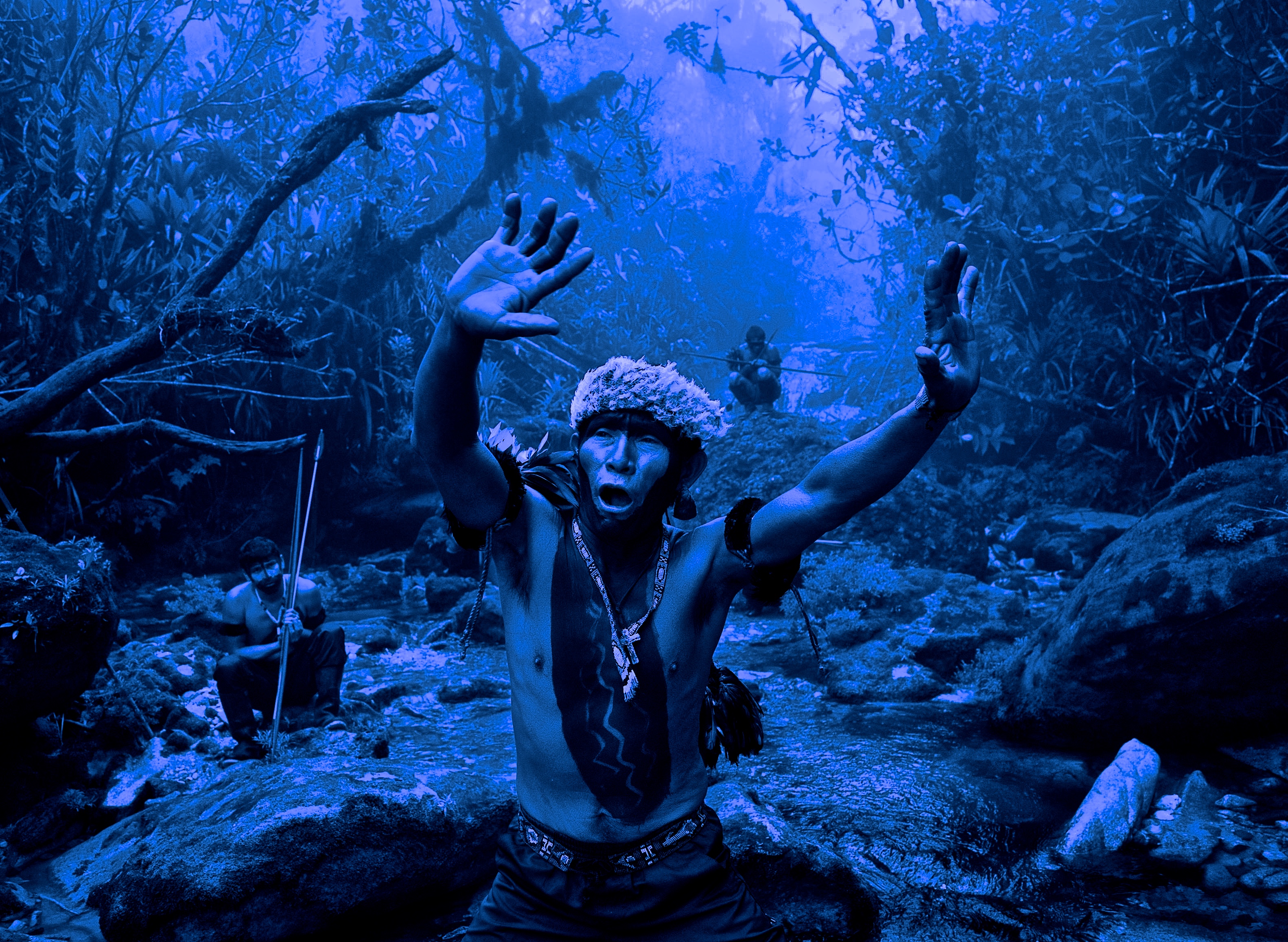 (Photo by Sebastião.)
(Photo by Sebastião.) (A field full of purple loosestrife, in Washington, Connecticut.)
(A field full of purple loosestrife, in Washington, Connecticut.)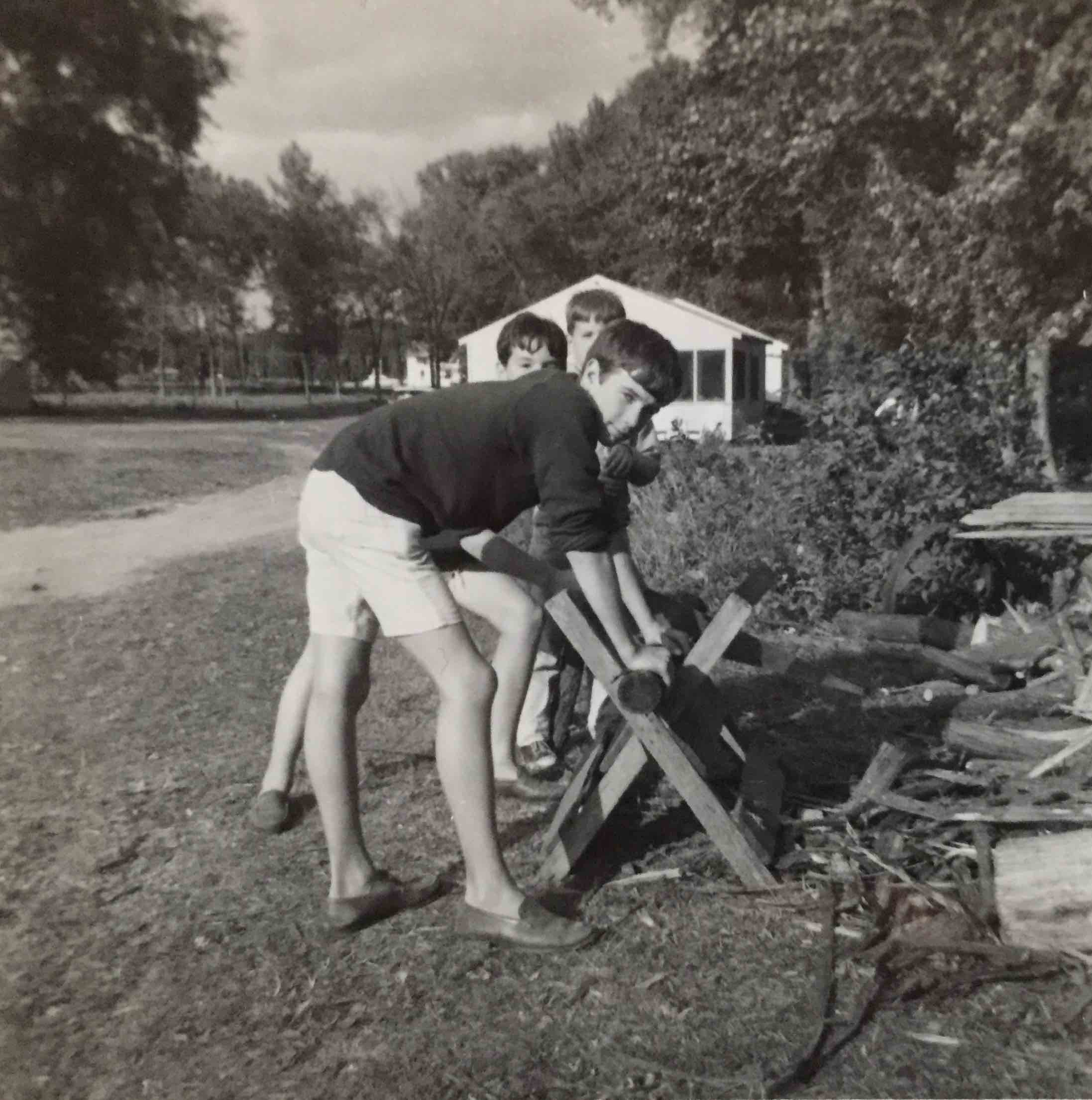 (Me, age 13, August 1964, in front of my brothers Dave and Rob, up in Vermont, on Isle La Motte, trying not to think about returning to school in two weeks. But we had the Labor Day Fair to look forward to.)
(Me, age 13, August 1964, in front of my brothers Dave and Rob, up in Vermont, on Isle La Motte, trying not to think about returning to school in two weeks. But we had the Labor Day Fair to look forward to.)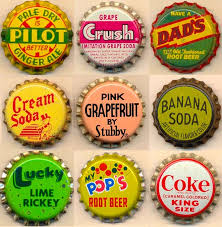
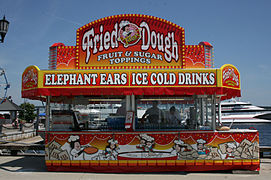
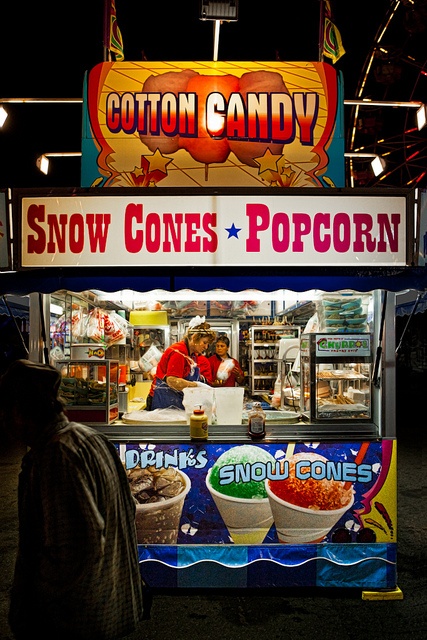
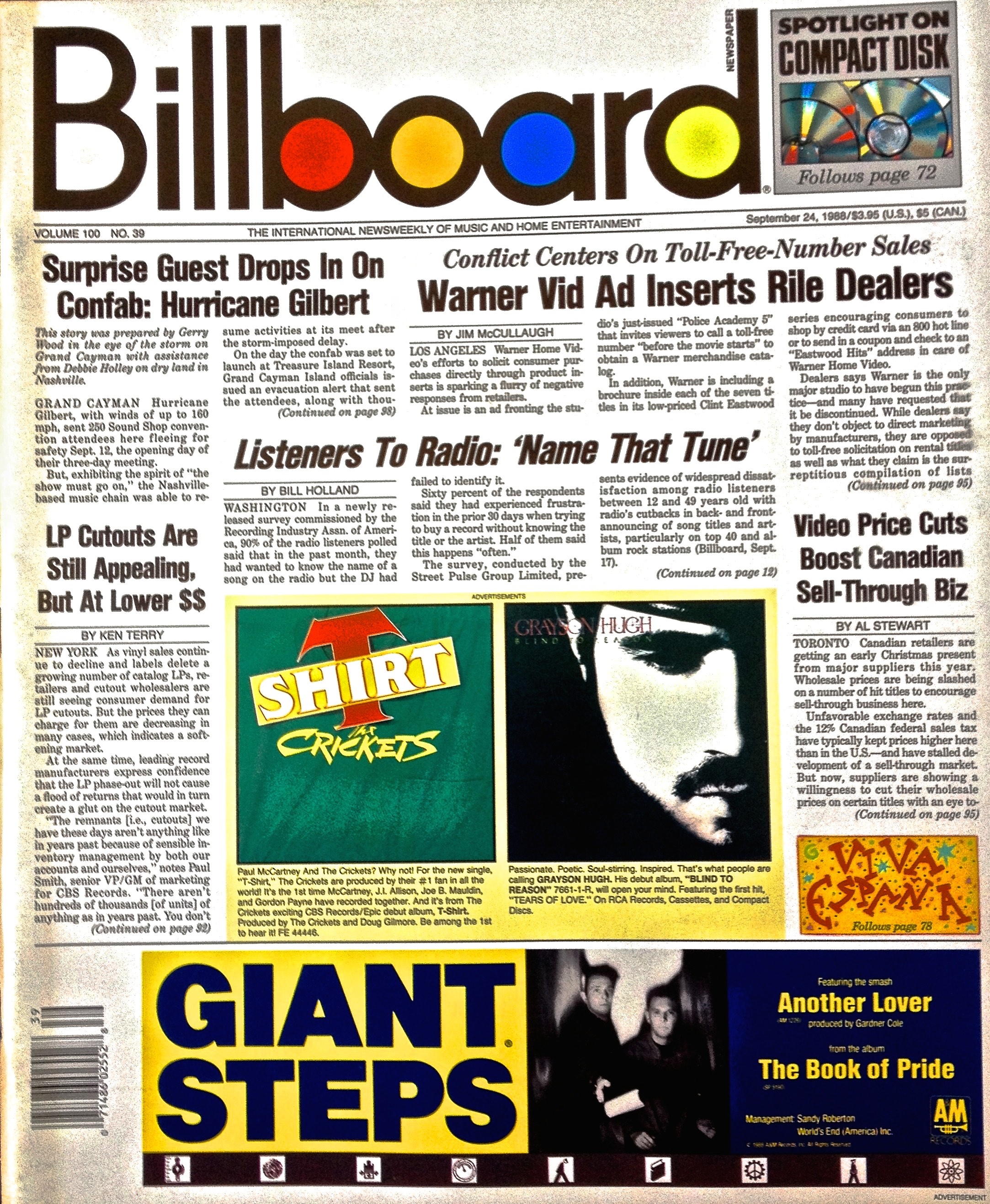
 (The beach, like the moon and sun, is always there.)
(The beach, like the moon and sun, is always there.)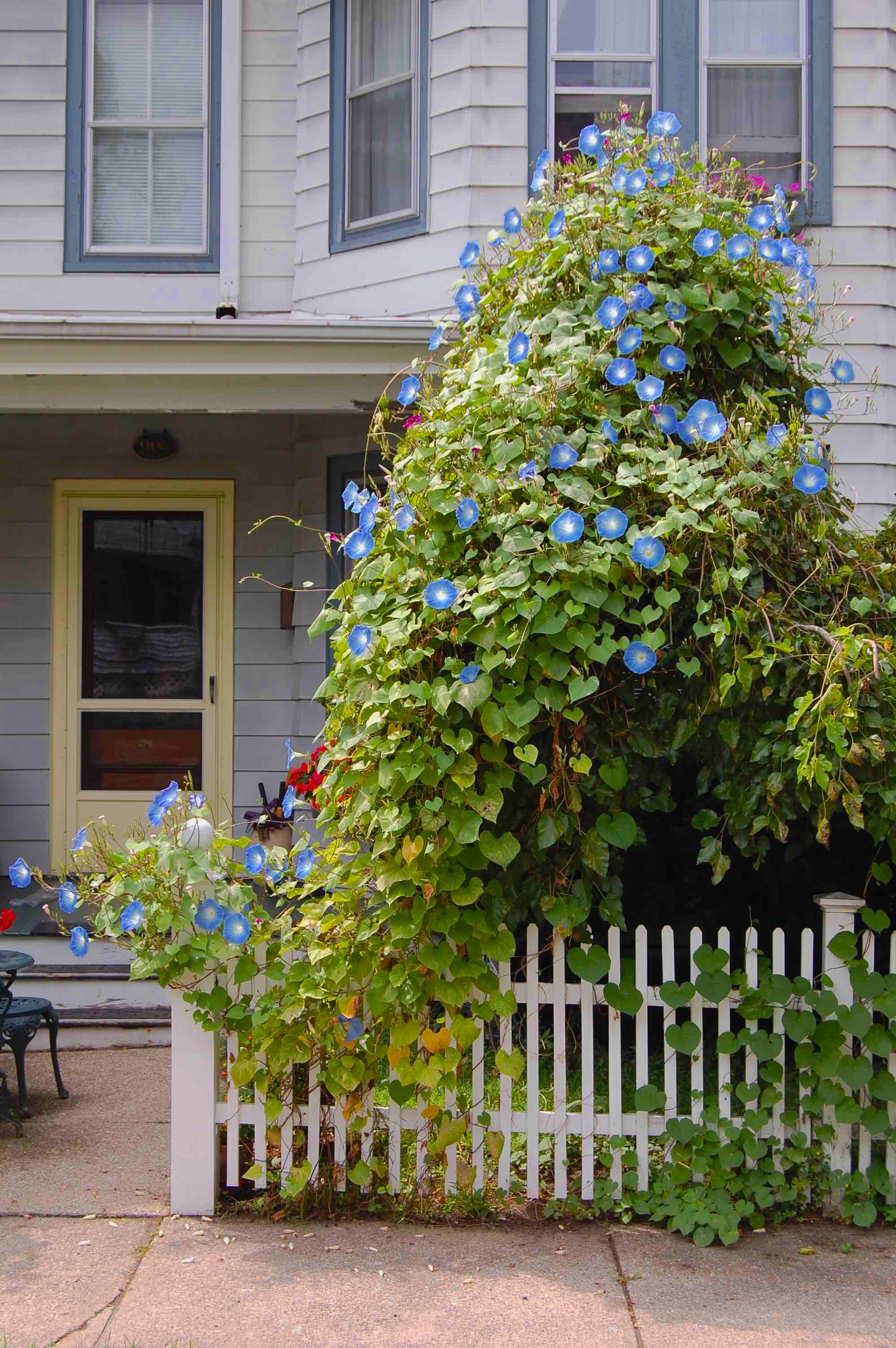


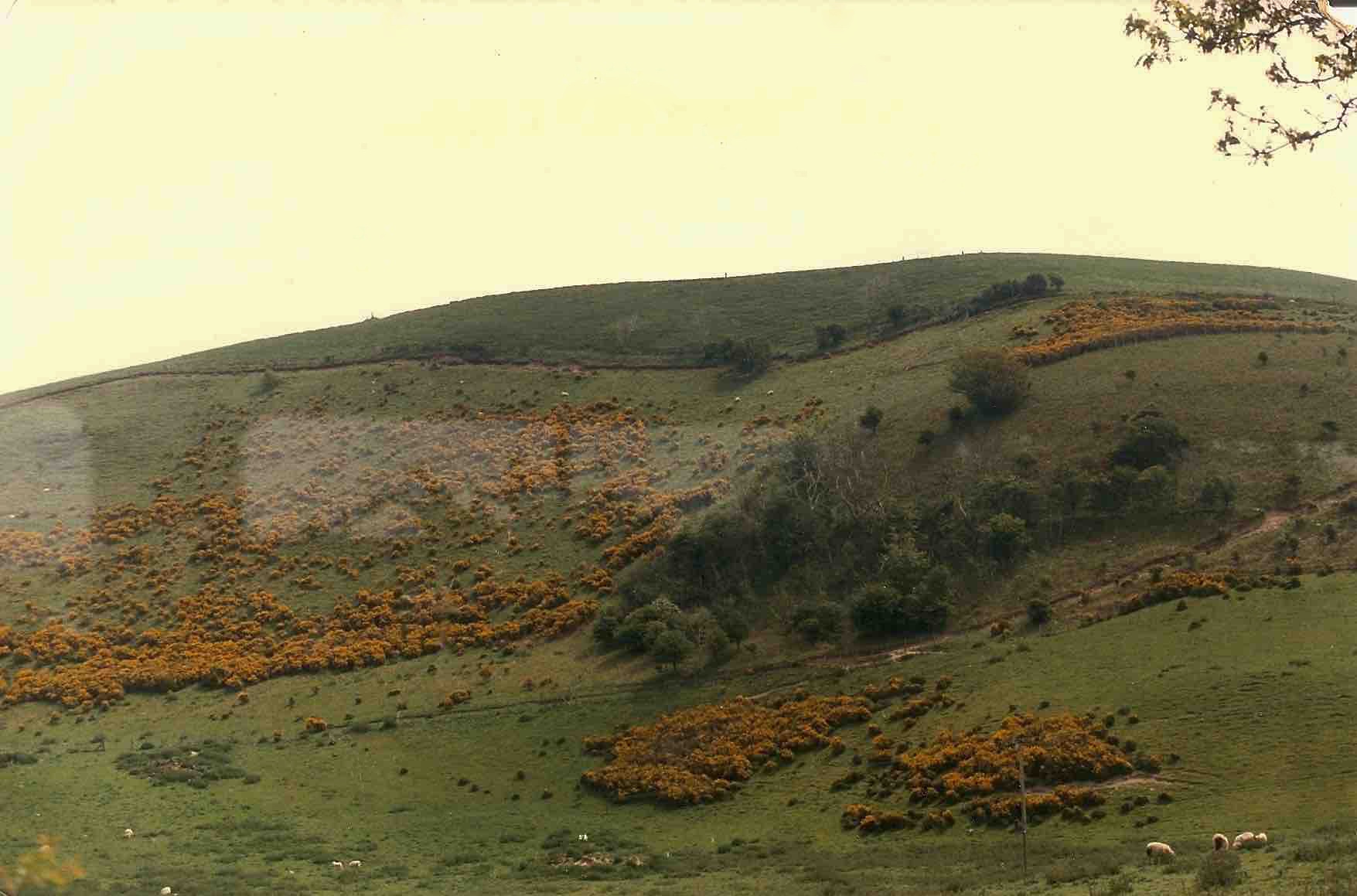

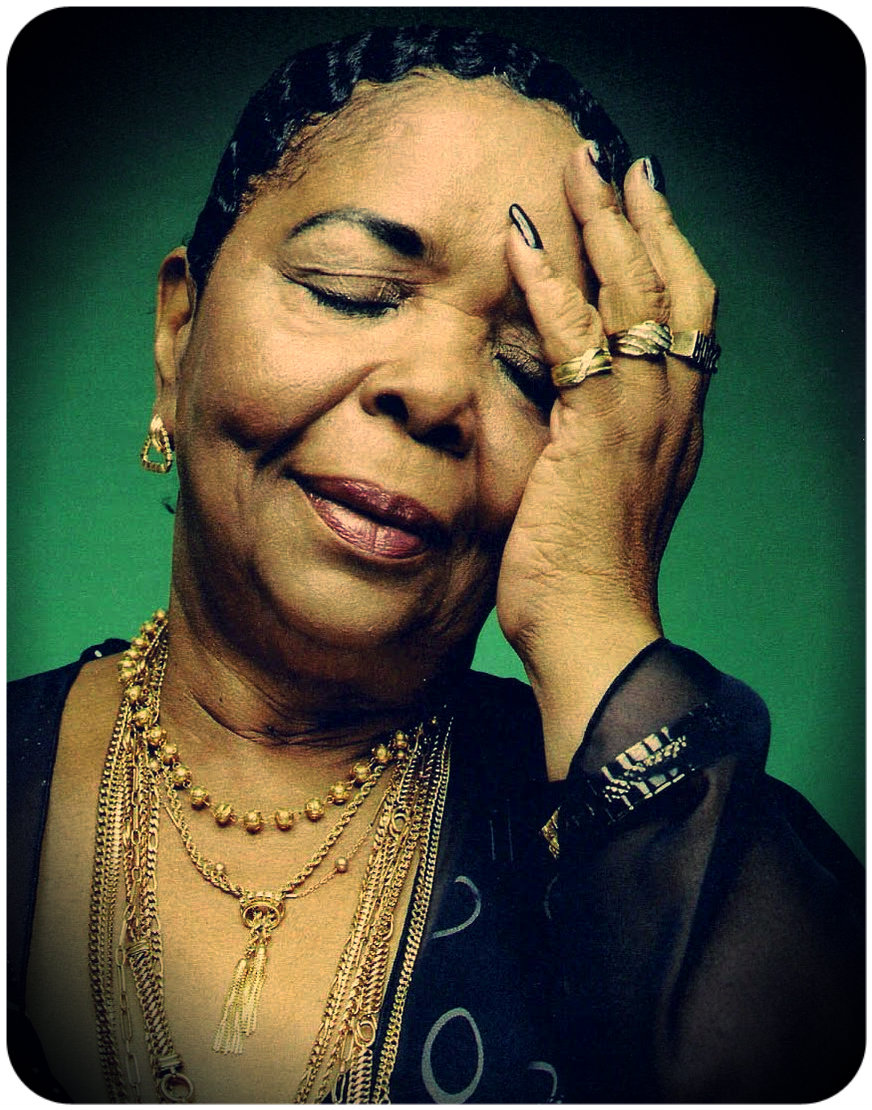 (Cesaria Evora.)
(Cesaria Evora.) (Cristina Branco.)
(Cristina Branco.)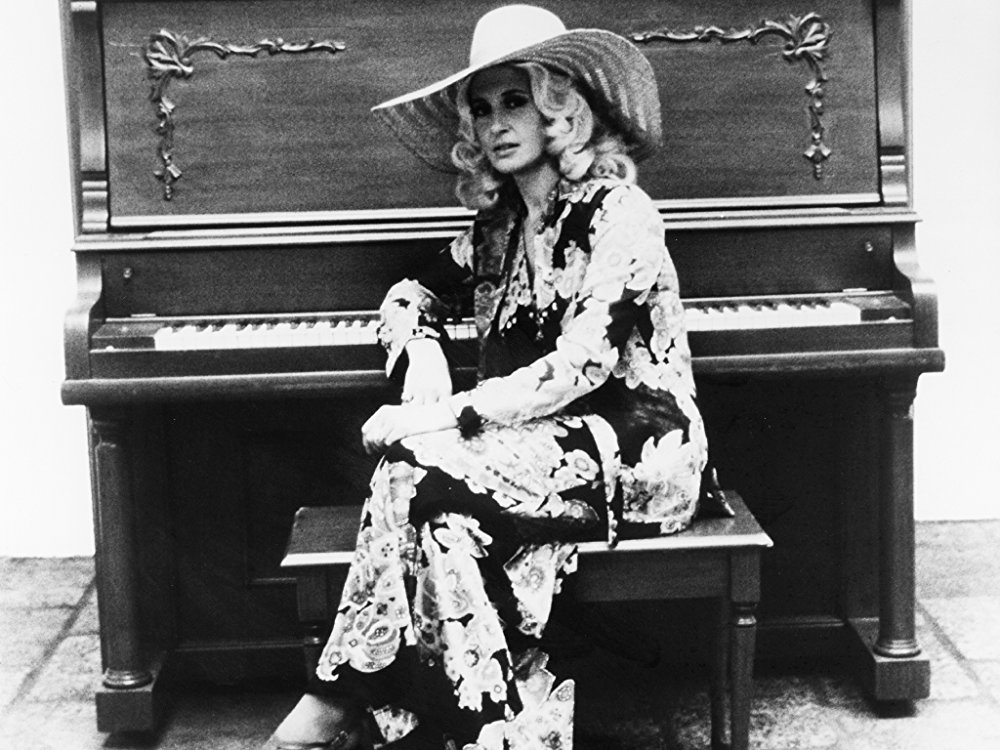 (Tammy Wynette.)
(Tammy Wynette.) (Marvin Gaye.)
(Marvin Gaye.) (B.B.King.)
(B.B.King.) (Bryn Terfel.)
(Bryn Terfel.) (Neli Andreeva, in center, and The Philip Kutev Choir.)
(Neli Andreeva, in center, and The Philip Kutev Choir.)